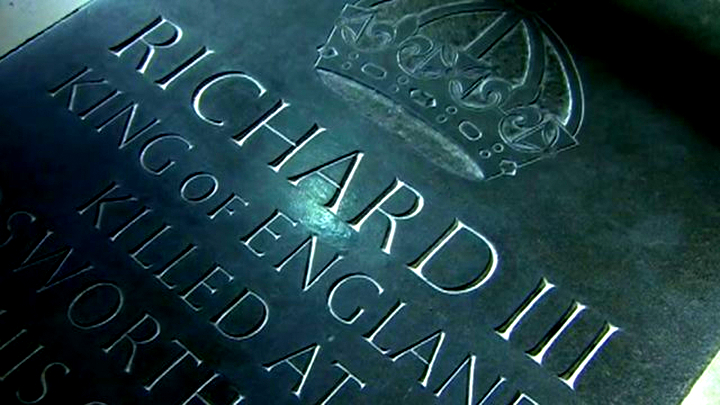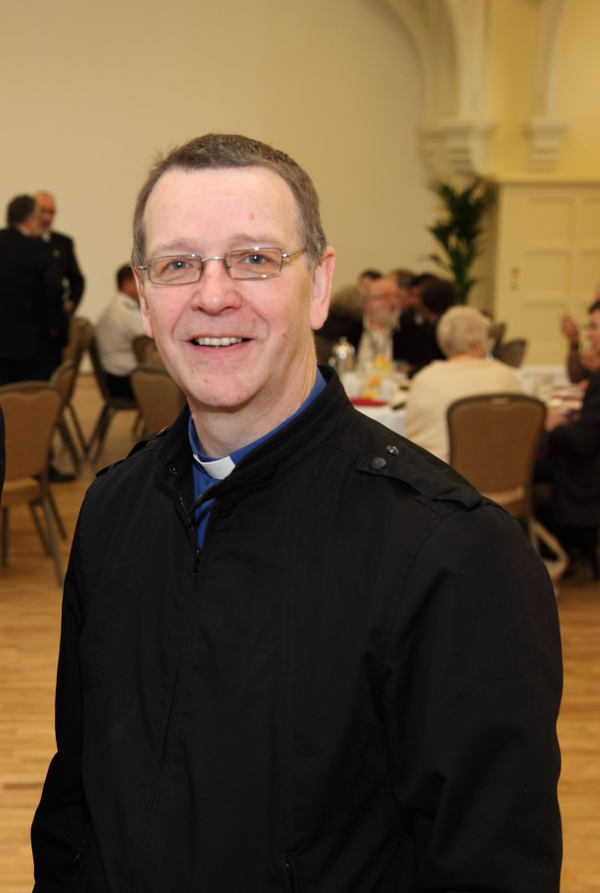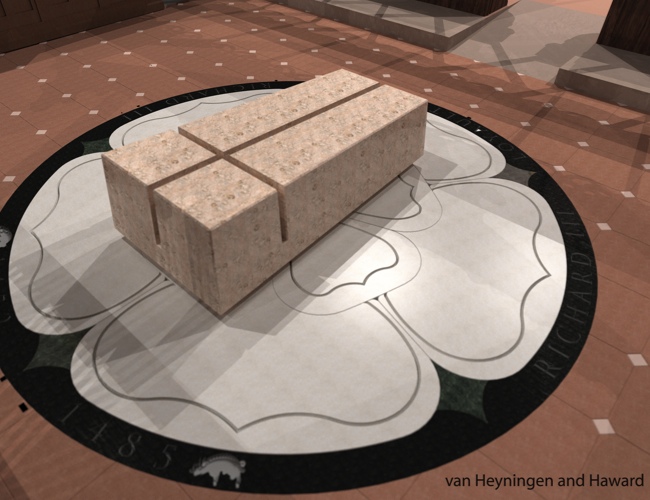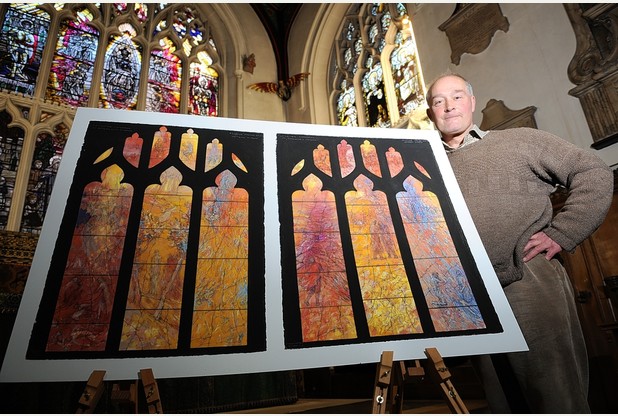
“We believe it is right that King Richard III stays in Leicester, and that his remains are reburied in our Cathedral.” states Leicester Cathedral’s new website, King Richard III in Leicester. “We intend to carry out the reburial of this anointed King of England on behalf of the whole nation with dignity and honour.” Leicester City’s right to reinter the remains of King Richard III has been challenged. But Leicester Cathedral remains firm on their stance that Richard III should be buried in the city where he was first laid to rest almost 529 years ago, and where he was rediscovered 527 after he was buried at the Greyfriars Church.

Reverend Pete Hobson, who is overseeing the arrangements for the reburial of King Richard III told us:”First and foremost, we are responding to a request from the University, in accord with a legally binding licence for exhumation. So we’re complying with the law. The fact that it has since been challenged doesn’t change its current legal status.
But beyond that, the church believes in the sanctity of burial sites, and the presumption of permanence. That means that whilst none of us can offer guarantees for all time, we think that when a body is placed into its final resting place, it should mean just that. That’s why not only archaeological but also ecclesiastical best practice is, wherever exhumations have taken place, and reburial is the plan, that it should take place in the nearest consecrated ground. Which is St Martins Cathedral.”
“Also, we believe that to rebury as near as possible to the long-standing site of the grave is consistent with the outcome of history. Whatever people may wish had happened, or speculate as to his wishes in an alternative universe, the facts remain that he fought and was defeated and killed where he was, at Bosworth, and was buried where he was in Leicester. To move the remains around according to some speculative idea of what might have been is to seek to play fast and loose with historical fact.”
The legal challenge over King Richard’s remains will take place at the High Court, in London, on March 13. A judicial review will now decide whether the procedure that led to his remains being exhumed in Leicester and the decision to reinter them at the city’s cathedral was conducted correctly. The review has already held up the reinterment ceremony planned for Leicester Cathedral while the Plantagenet Alliance, a group of descendants of Richard III’s brothers and sisters which formed after his remains were discovered, argues that they should be consulted on his final resting place. The Plantagenet Alliance claims Richard would have wanted to be buried in York, nominating York Minster as their preferred place, and are gathering statements of public support from celebrities such as Julian Fellowes, Judi Dench and Derek Jacobi. Leicester Cathedral, however, is not slowing down. Plans for Richard III’s reinterment ceremony are forging ahead regardless.
“A lot of people misunderstand this point but what we’re dealing with simply a version of the much more recognised ‘presumption of innocence’, namely that you can’t assume the outcome of a legal process before it’s taken place,” Reverend Hobson told us “So having a judicial review doesn’t make the current licence any less legally binding – unless and until a court were to find to the contrary. Which we think they won’t, by the way. But of course some people, who’d like to see the licence over-turned, make a lot of the fact that we’re proceeding on the basis that its requirements are binding on the University and us. But that’s the whole point. They are.”
“We’ve said we clearly won’t go ahead with an actual reinterment until the legal position is clear,” he added “But it’s very naive to think there’s not an awful lot of planning to do to be ready for that moment, and it would be a serious dereliction of duty on our part to sit on our hands and refuse to do it. And if, by any unlikely chance, the legal processes did result in a requirement for some other place to bury the remains – does anyone seriously imagine they wouldn’t have to make comparable arrangements to those Leicester is contemplating? The worst outcome of all would be for a long delay legally to be followed by an even longer pause whilst either we, or indeed some other place, desperately worked out if they could actually go ahead anyway – not just legally, but practically and organisationally.”
York Minster can be slow on the uptake. It took them 15 years to agree to house the commemorative stained-glass window of Richard III, eventually donated by the Richard III society. The Minster is also full. In Leicester Cathedral, however, the tomb would be positioned in a special area defined by wooden screens, with the tomb facing the Cathedral’s “magnificent east window depicting Christ the King coming in victory at the last”.
Plans for the re-design of the cathedral interior are still under wraps, as the Church Fabric Commission for England wants to wait until the resolution of the High Court review. “This is a process that’s still under way, so no-one should assume they know the outcome until permission has been given by the body which does that for all English Cathedrals, but we’re hopeful that will come in March,” Reverend Hobson told us. ” But in brief we plan a three-stage process, whereby King Richard’s remains will be reinterred below ground level; his name, title, and associated honours will be commemorated in words and symbols on and around floor level, and then above ground will be a magnificent tomb-stone of Swaledale fossil stone, within which is deeply inscribed a cross – the universal Christian symbol that would have been at least as deeply meaningful to Richard as to anyone living today. In that way both the man, and the monarch will be represented, framed in the context of Christian faith and symbolism.”

“The crown John Ashdown-Hill has commissioned and offered to us will have a central place in our ceremonies. We’ve also commissioned a beautifully hand-crafted pall to go over the coffin – the full details of which will only be revealed at the time of the events themselves.”
“Beyond that we are commissioning a beautiful stained glass window, which will go into St Katharine’s chapel immediately north of the grave space, and be created by the leading artist Tom Denny, whose recent works include windows in both Durham and Hereford Cathedrals. In multi-faceted detail it will both tell the story of Richard’s life and death but also inspire contemplation of the human story of his life and ours.”

Further plans for the reinterment ceremony, which will include a reception and repose, where the coffin will lie at rest for several days giving the public the opportunity to pay their respects, are outlined on the Richard III in Leicester website page Reburial, which Reverend Hobson told us “outlines the processes we think are fitting to the occasion – and emphasises throughout that what we are aiming at is services and surrounding event redolent with a dignity and honour appropriate to the man and the occasion. We can’t say a lot more yet about the detail – not least because, despite what some may imagine – it’s not actually finalised yet, nor is it reasonable to think it could be. But we have some very good brains and hearts working on it, and are very aware both of liturgical practices from Richard’s time and of the need to be both intelligible and relevant to a world-wide audience of the 21st century.”
There has been some concern over Richard III having a Catholic ceremony. Reverend Hobson explained: “There’s been widespread misunderstanding on this point, which might be summed up in the way people use the word ‘Catholic’ when what they really mean is ‘Roman Catholic’. Richard lived before the Reformation when the very term Roman Catholic wasn’t in use – and all English Christians were Catholic, that is they all saw themselves as part of the one, world-wide church. But what is clear is that since the English Reformation, the Church of England is, in law, the true Catholic church of the land, in full continuity with the earlier generations. Moreover the churches Richard worshipped in are, where they still stand, the churches that now belong to the Church of England – and St Martins Cathedral is a case in point. It was there in King Richard’s time, and it’s still there now.
So of course our service will be catholic – how could it not be? But it won’t be Roman Catholic as such – a later innovation! Richard, the former monarch, will be reinterred by the same church whose supreme governor is the current monarch. What could be more fitting? Having said all that, since there is now a Roman Catholic church in the land as well, we have been in touch with the local Roman Catholic Bishop, who is very supportive of our plans, and who we’re sure will be amongst our honoured guests when we come to it.”
Leicester certainly seems to feel an obligation to King Richard III and are preparing for city-wide commemorations. The Cathedral is of course planning a new interior design to house Richard III’s tomb with honour. The visitor centre will house an extensive, two-floor exhibition named The King Richard III: Dynasty, Death and Discovery. The much-admired James Walter Butler sculpture will be joined by a new installation Towards Stillness, a series of plates which will chronicle the life, death and rediscovery of Richard III in the new plans for the Cathedral Gardens. The University of Leicester is also running free online courses for the public, England in the time of King Richard III. Richard himself might be amazed.
“I think Richard should be reburied in Leicester because, as far as we know, no member of his immediate family sought to have his body removed to York (or anywhere else) in the months and years after 1485,” Historian and acclaimed Richard III biographer David Baldwin told us “And if they were content with the situation, perhaps everyone else should be too.”



